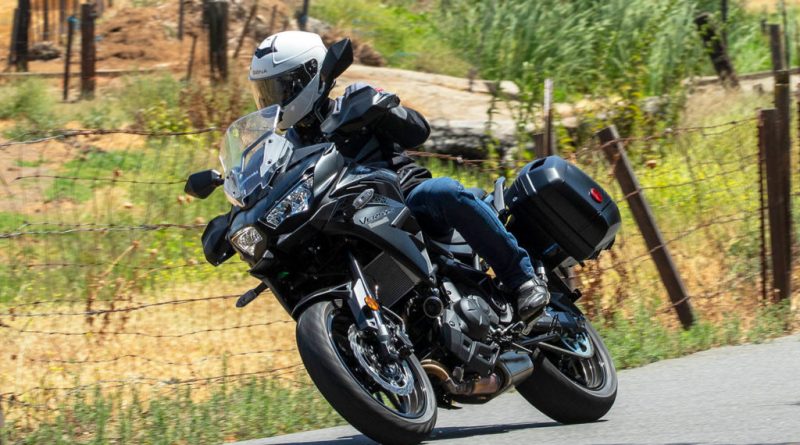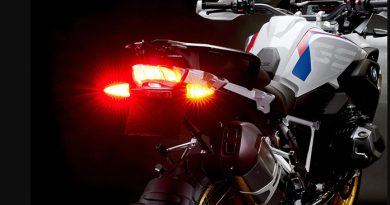2022 Kawasaki Versys 650 | First Ride Review
Kawasaki’s venerable Versys 650 sport-tourer has been updated for 2022 with traction control, updated styling with an adjustable windscreen, and a new TFT display with Bluetooth connectivity. Photos by Kevin Wing.
My 2009 Kawasaki Versys 650 was one of the best utilitarian two-wheelers I’ve owned, but since I’m always putting miles on test bikes, I hardly ever rode it. When I realized I’d added only 500 miles to the odometer in five years, a deep sense of shame prompted me to sell it. After listing it on Facebook Marketplace, it was gone in a flash. Due to the high prices for used motorcycles right now, I earned a small profit – about a dollar for every mile I put on it.
The only colorway for the 2022 Kawasaki Versys 650 LT is Metallic Spark Black/Metallic Flat Spark Black.
Flash forward a few months and I’m wending my way through the twisty interior of San Diego County aboard a 2022 Kawasaki Versys 650. It’s the $9,999 LT version with hard saddlebags and handguards, which only comes in Metallic Spark Black/Metallic Flat Spark Black this year. The base model is available in the same color for $8,899, or in Candy Lime Green/Metallic Flat Spark Black/Metallic Spark Black for $9,099.
Check out Rider‘s 2022 Motorcycle Buyers Guide
Not surprisingly, the 2022 upgrade is a much better motorcycle than my just-sold 2009 model, but they still have a lot in common despite 13 years of separation. The seating position, performance, and overall essence of the motorcycle remain virtually unchanged, but a few key aspects go a long way toward improving the bike’s desirability.
The new TFT display is a welcome upgrade. The screen is bright and easy to read.
New for ’22 is a full-color 4.3-inch TFT display that is a major improvement over the previous instrument panel, and light-years beyond the one on my ’09 model. The layout of information is modern and clean, blending everything – the gear position indicator, fuel gauge, tach, speedo, clock, tripmeter, etc. – into a centrally located format. A rider can choose between a black or white background, and the screen brightness automatically adjusts to ambient light levels.
Gear Up:
Helmet: Sena Impulse
Jacket: Spidi H2Out
Gloves: Spidi TX-2
Pants: Rev’It Campo
Boots: Alpinestars SMX-1 R
Simultaneously depressing two analog buttons on the display allows a Bluetooth connection to be established between the Versys and Kawasaki’s Rideology smartphone app. The app features a useful and handy maintenance log, general bike info, and the ability to record rides as well as share them with others.
During the ride, when the bike and app are talking to one another, the TFT display will notify the rider when a new call or email has been received. The part of my ride recorded with the Rideology app showed that I traveled 79 miles for 1.34 hours from Orange to San Diego counties at an average speed of 54 mph. The map, however, displayed a straight line from point A to point B, not an accurate GPS mapping of the twists and turns.
My old Versys’ windscreen was adjustable only if I were willing to remove the four bolts necessary to position it differently, which rarely, if ever, happened. The inefficiency of the process meant a rider found a likable position for the windscreen and that’s where it stayed. The new Versys features an easily adjustable windscreen that can be raised and lowered to four different settings over a 3-inch range. It’s a two-handed affair with one hand depressing the lock button while the other moves the windscreen, but it’s worth the small effort. The upper position deflects wind quite well while the low position puts the rider more in the wind stream.
The new windscreen is the cherry atop a redesigned upper fairing that shares a family resemblance with its liter-bike counterpart, the Versys 1000. The sides of the new cowling are ducted to move air around the rider while the dual headlights are now bright, low-wattage LEDs. The rear of the Versys matches the front with aggressively pointy style and a new LED taillight.
Anti-lock brakes now come standard on all Versys 650 models, as does traction control. The 649cc liquid-cooled parallel-Twin powering the Versys isn’t a tire shredder – when we dyno tested a 2020 Versys 650, it sent 63 hp and 43 lb-ft of torque to the rear wheel – but it can certainly break traction given enough throttle when leaned over. TC has two settings, with the first being less intrusive and the second providing a more conservative safety net that should prove beneficial to newer riders or experienced ones caught in low-traction conditions. If desired, traction control can be switched off entirely via a switch located on the left switchpod.
Kickstand up and traveling south on Interstate 5 toward San Diego, the Versys felt like a comfortable and familiar old shoe. Exiting the slab and venturing into the twisties, it soon becomes apparent the Showa suspension’s stock settings were a tad soft for my taste. Once stopped, a few stiffening clicks of preload on top of the left fork leg, a few clicks of tensioning rebound on top of the right fork leg, and a few stiffening twists of the remote preload adjuster on the rear shock dialed things in for tackling the road ahead.
The 28-liter saddlebags are large enough to accommodate a full-face helmet, though without much room to spare. There is also a helmet lock if you need to secure your lid when the saddlebags are full of other incidentals. The ignition key unlocks the saddlebags and allow them to be removed from the motorcycle. For those requiring more storage, Kawasaki offers a matching 47-liter top case along with other accessories, such as heated grips and a GPS mount.
The bike’s peppy midrange thrusts its 503-lb claimed curb weight forward in enthusiastically manageable fashion. Dual 2-piston calipers grip 300mm petal discs to slow the party down with equal efficiency. When leaned over, the Versys holds its line effectively and transitions to and fro confidently.
The 5.5-gallon fuel tank combined with efficient fuel consumption allows for extended mileage between fuel stops. (During our 2020 test, we averaged 46 mpg for 253 miles of range.) That’s great news for commuters or anyone wanting to incorporate longer trips into their Versys ownership. Complementing the Versys’ fuel range is an ergonomically neutral riding position that is one of the things I loved most about my old Versys as well as the new one.
Like my old Versys, the new version is a modern, solid, middleweight jack-of-all-trades that’s as steadfast as a motorcycle can be. It responds dutifully to what’s asked of it, whether that be cruising around the city, commuting to work, or taking off on long weekends or longer tours. During my Versys ownership never once did it fail to start, or run badly once started, even though it spent most of its time languishing in my garage.
My old Versys didn’t have ABS, traction control, a remote preload adjusting shock, TFT display, a slip/assist clutch, LED lights, or an easily adjustable windscreen, and it didn’t look nearly as good as the ’22 Versys. In 2009, the MSRP of a base-model Versys was $7,099, which is just over $9,700 in today’s dollars. The new bike offers much more for less money, and the touring-ready LT is a fantastic bargain.
2022 Kawasaki Versys 650
Base Price: $8,899
Price as Tested: $9,999 (LT model)
Website: Kawasaki.com
Engine Type: Liquid-cooled, transverse parallel-Twin, DOHC w/ 4 valves per cyl.
Displacement: 649cc
Bore x Stroke: 83 x 60mm
Horsepower: 63 hp @ 8,700 rpm (rear-wheel dyno, 2020 model)
Torque: 43 lb-ft @ 7,300 rpm (rear-wheel dyno, 2020 model)
Transmission: 6-speed, cable-actuated slip/assist wet clutch
Final Drive: Chain
Wheelbase: 55.7 in.
Rake/Trail: 25 degrees/4.3 in.
Seat Height: 33.3 in.
Wet Weight: 503 lb (as tested)
Fuel Capacity: 5.5 gals.
Fuel Consumption: 46 mpg
Rider Motorcycle Buying Program. Get up front prices on local inventory. View Inventory
The post 2022 Kawasaki Versys 650 | First Ride Review first appeared on Rider Magazine.


